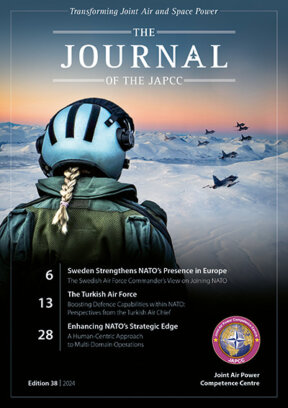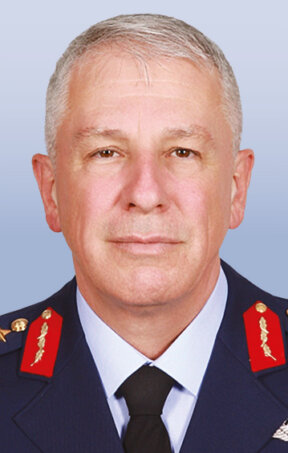‘Türkiye plays a crucial role in maintaining regional stability through its efforts to deter security threats using its military capabilities.’
What are the current air and space capability developments in the Turkish Air Force?
Before I get into the details of the capability development roadmap, I would like to summarize the Turkish Air Force (TÜ AF) concept mindset with some examples. The TÜ AF has initiated modernization and R&D projects with a roadmap through 2050 to enhance its operational effectiveness and acquire advanced capabilities, leveraging cutting-edge systems and platforms. Our ambitious project roadmap focuses on the development of aircraft systems, such as the fifth generation KAAN low visible, multi-role fighter aircraft, trainers such as HÜRKUŞ and HÜRJET aircraft and GÖKBEY helicopter, and Unmanned Aerial Vehicle (UAV) systems such as ANKA, AKINCI, AKSUNGUR, BAYRAKTAR TB3, and KIZILELMA. When it comes to space capabilities, our priority is to enhance our existing space-based ISR capability, and our space projects are initiated accordingly. Furthermore, our air and missile defence concept is being bolstered by HİSAR and SİPER air defence missile systems, as augmented by next-generation Early Warning Radar systems. A forthcoming procurement initiative is set to replace the T-38M, which is expected to be completely phased out of service by the mid-2030s, with a modern trainer aircraft. Specifically, the HÜRJET project seeks to fulfil the requirements for jet training and aerobatic capabilities, thereby ensuring continuous training of pilots and aerobatic team members. Since 2018, the TÜ AF has been operationally utilizing UAV systems designed and developed with national capabilities to meet reconnaissance and surveillance needs. The procurement of high-altitude UAV platforms, including AKINCI and AKSUNGUR, has enabled the TÜ AF to expand its capacity in close air support, air-to-ground attack, and electronic warfare missions. These platforms have remarkably enhanced ammunition and payload-carrying capacities. Currently, the development of next-generation stealth UAV systems, including ANKA-3 and KIZILELMA is still ongoing. In alignment with the fundamental principles of peaceful and defensive utilization of space, and consistent with international best practices, we have identified key areas for capability development. These areas include force development, space support, and space control. In order to protect our national space assets against threats and hazards, we have recently established our own Space Command under the Turkish Air Force. The space project roadmap consists of space-based Electro-Optical (EO) and Synthetic Aperture Radar (SAR), electronic support, regional Positioning, Navigation, and Timing (PNT), and early warning satellite systems. We are aware of the fact that space domain awareness is the key to space warfare, and we are planning to have our own space situational awareness capability.
What are the current challenges the TÜ AF is facing?
As other NATO nations, we face common global challenges, including health crises, climate change, and social issues that necessitate a multidisciplinary approach that encompasses both security and economic considerations. Furthermore, we are witnessing a profound shift towards an information and technology-driven society, precipitated by the cumulative effects of globalization and digitization, which demands a comprehensive understanding of the interconnected nature of these developments. Furthermore, we carefully consider these factors and incorporate lessons learned into training protocols to mitigate the impact of climate change on operational capability. Our Search and Rescue units are actively engaged in responding to natural disasters, which necessitates continuous updates to our operational approach. Moreover, our humanitarian aid mission effectiveness has also been enhanced through this adaptive strategy. The individual and societal benefits associated with these factors are integrated into training programs to ensure that operational capacity is not compromised in environments affected by climate change and health issues. Our units continually refine their operational protocols to adapt to increasing natural disasters such as floods and earthquakes. This has been particularly evident in the wake of recent earthquake disasters that have significantly impacted our country, yielding valuable lessons learned and the development of new projects. It is imperative to establish a military force structure comprising a judiciously allocated number of personnel with high mobility and firepower, capable of rendering both direct and indirect support to international operations. This force should be equipped with weapon systems that are commensurate with the technological advancements of the present era, enabling effective and efficient execution of its mandate. A personnel structure integrated with its corporate culture and trained in accordance with current developments is a valuable asset that cannot be replicated or replaced by competitors. The first element of our success in the 21st century, where our understanding of security and our mission types are diversified and uncertain, is a very well-equipped and psychologically resilient workforce. In light of the evolving needs of the modern age, the importance of modern weapons systems is becoming increasingly apparent. The ability to operate, use, and manage these systems effectively, and make the right decisions in complex battlefield conditions, is becoming a crucial skill for personnel. In addition, the role of commanders in directing and managing these systems turns is increasingly significant. The personnel structure in the 21st century should be more flexible, agile, and professional. The proliferation of weapons systems to terrorist groups has created new challenges, as they can now employ unconventional tactics with devastating effects. This development underscores the need for militaries to adopt asymmetric strategies and enhance command and control relationships to effectively counter these unconventional threats. The increasing globalization of the satellite and aerospace industry has resulted in a scenario where various countries with established space programs can now manufacture key subsystems, ground systems, and components. This development has led to a reliance on a limited number of suppliers, thereby increasing the risk of supply chain disruptions and potential project delays. Consequently, it is essential to develop alternative logistics strategies for the space and aerospace sectors to mitigate these risks and ensure the timely delivery of critical products and services. Investing in the space domain has been hindered by the scarcity of trained professionals in this field, as well as the significant resource requirements arising from the incorporation of cutting-edge technologies into the systems, subsystems, and components utilized.
How would you assess the global and regional situation around Türkiye, and the air and space contributions of the TÜ AF to ongoing NATO operations and missions?
Located in the southeastern wing of NATO, Türkiye faces a unique set of security challenges due to its proximity to a complex regional environment marked by interstate competition and terrorism. Despite these challenges, Türkiye plays a crucial role in maintaining regional stability through its efforts to deter security threats using its military capabilities. The global security environment is closely monitored, and transformative studies are conducted to enable the TÜ AF to respond effectively to emerging challenges in a timely manner. NATO actively promotes international peace and security, remaining vigilant and engaged in global affairs. The TÜ AF is recognized by NATO as a vital contributor to the Alliance’s operational capability. Through collaborative efforts with NATO members, the TÜ AF is committed to supporting Alliance operations and missions, with all units adhering to NATO’s rigorous training and operational standards. The TÜ AF organizational structure is harmonized with the NATO Defence Planning Process, ensuring cooperation and coordination with other stakeholders. We place significant emphasis on supporting the NATO Warfighting Capstone Concept (NWCC) initiative undertaken by NATO Allied Command Transformation, specifically adhering to the Warfare Development Agenda (WDA). Based on the lessons derived from these efforts, we prioritize enhancing our transformation pace and optimizing the combat readiness of our troops through a rigorous and standardized certification process. Upon the 72nd anniversary of Türkiye’s accession into NATO, we remain committed to upholding NATO’s values and core mission, just as we always have. In line with the principles of fair burden sharing, the TÜ AF has been actively engaged in various NATO endeavours, including contributions to the NATO New Force Model and Allied Reaction Force. TÜ AF personnel have been deployed to support NATO Mission Iraq (NMI) and Kosovo Forces (KFOR), while also participating in NATO exercises and peacekeeping operations through Enhanced Air Policing, Airborne Early Warning, and Air-to-Air Refuelling missions. Additionally, as an alternate Joint Force Air Component Command (TÜ JFACC), the TÜ AF aims to assume increased responsibility within the Alliance in the near future. The TÜ AF has been actively supporting NATO space activities since 2012. We are fully engaged in the NATO space domain implementation plan, and we display this effort by sending our space SMEs to space-related NATO exercises, contributing to space doctrine development efforts, and filling our billets within the NATO Command Structure/NATO Force Structure (NCS/NFS) space C2 structure. We provide high-resolution space-based E/O imagery to fulfil NATO joint ISR, Find, Fix, Track, Target, Engage, Exploit and Assess (F2T2E2A), and focused collection activity requests. And finally, we are one of the 15 nations that established the NATO Space Centre of Excellence in Toulouse, France. Once the Turkish Space Command reaches its full operational capability, it will contribute to other space operational functional areas besides space-based ISR.
What are your insights on the future of NATO’s joint air and space power capabilities, and what roles do you envision the Turkish Air Force fulfilling?
The advent of advanced technologies has not only brought about numerous benefits; it also poses significant security concerns for NATO. The proliferation of hypersonic missiles, coupled with the emergence of cyber and asymmetric threats, presents a formidable challenge to both neighbouring countries and the Alliance. To effectively mitigate these threats, NATO must undergo a rapid adaptation process across all domains and proactively prepare for future security risks in order to safeguard the territory and personnel of the Alliance. To effectively counter and deter potential threats, NATO needs to prioritize the attainment of information superiority, which can be achieved by gaining access to critical information before adversaries and leveraging this advantage to inform decision-making. Developing a robust Joint Air Command and Control (JAC2) structure of the future is crucial in this regard, necessitating integration of innovative technologies such as Artificial Intelligence (AI), cloud computing, and big data analytics to expedite and enhance the decision-making process. Adopting cloud technology is expected to facilitate a paradigm shift from a single, monolithic platform to a system of systems architecture, ultimately enabling the realization of a Multi-Domain/Joint All-Domain environment. This transformation will likely lead to an accelerated operational tempo and decision-making processes, as AI will be integrated to support critical decision points. Moreover, it is anticipated that a unified information architecture will be established, providing a single, comprehensive information set for all decision-makers, thereby ensuring information superiority and a unified operational picture across all domains promoting decision superiority. The TÜ AF plays a crucial role within NATO and its regional context, being dedicated to upholding its responsibilities. To maintain its status as a formidable and deterrent force, the TÜ AF prioritizes the development of a robust and sustainable air and space power infrastructure, recognizing the imperative for continued adaptability and competitiveness in an evolving security landscape. Through participation in global missions and joint exercises, our military has been actively engaging in efforts to enhance interoperability with NATO forces, prioritizing collaboration in the domains of air and space power. As we envision the Joint Air and Space Force of the future, we recognize ourselves as a crucial component, poised to leverage our capabilities to foster enhanced cooperation and adapt to an evolving operational landscape. The TÜ AF has maintained its efficacy and deterrent presence in its region, adaptively incorporating new technologies to enhance its capabilities. Over the next decade, the TÜ AF’s expertise in joint operations will continue to have a significant impact, particularly in the development of cutting-edge air defence, command and control systems, UAVs, radar systems, and combat aircraft projects. Moreover, the implementation of advanced Ballistic Missile Defense (BMD) and Integrated Air and Missile Defence (IAMD) systems will reinforce regional air defence capabilities, solidifying the TÜ AF’s role as a vital member within NATO.












